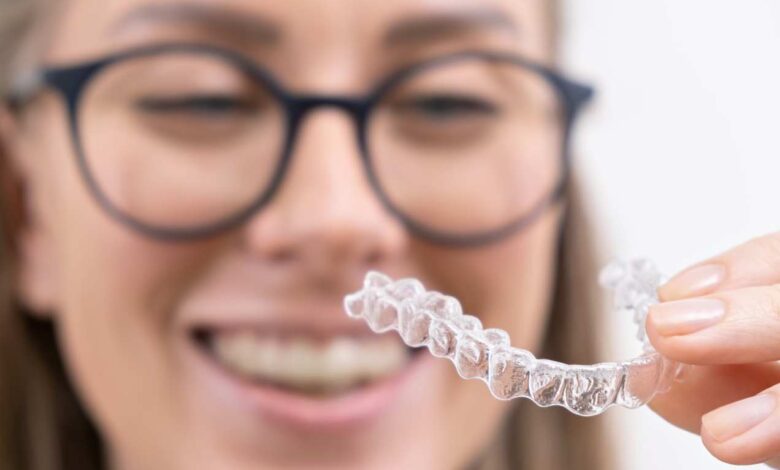Braces or Invisalign – Which Should You Choose?

Both procedures deliver a beautifully straight smile, yet the two differ in aesthetics, comfort, cost and the problems they can resolve. Read on below to discover the pros and cons — it’s the only way to make the right decision.
Aesthetics: Metal Braces vs Clear Aligners
Arguably, the most obvious difference between Invisalign and traditional braces is the way they both look. Braces consist of metal brackets and wires that are secured to the outside of your teeth. That’s why they’re so easy to see when you smile or talk. And while modern braces have evolved significantly over the years to be smaller and less bulky than in the past, it’s still pretty hard for the average person to hide the appearance of regular metal braces.
Invisalign, however, tackles the aesthetic issue with a completely different approach. Instead of using wires and brackets that everyone can see, Invisalign actually uses clear aligners themselves. An aligner is a thin, transparent tray made specifically for your mouth that can be taken on and off at any time. Even when you do happen to be wearing your clear aligners, very few people will ever be able to notice unless you point it out to them.
Thanks to this extra layer of authenticity, Invisalign is highly favoured by both adults and teens who are looking for the most visually discreet orthodontic treatment possible.
Comfort: Wires and Brackets vs Smooth Aligners
Because metal braces have brackets and wires, it can take a little while to get used to the feel of the metal against your cheeks, lips and tongue. Sometimes you might have a wire or bracket that sticks out or breaks, and this can poke the insides of your mouth. Having a bracket come off or a wire protruding can cause discomfort until you can get to the dentist to correct the issue.
Invisalign, on the other hand, uses smooth, thermoplastic trays that fit snugly over your teeth and are much less likely to irritate your lips, cheeks and tongue. Because each tray fits properly over your teeth, there is a very low chance that there will be dental spurs or other issues.
Most people find that they are more comfortable with plastic aligners than metal braces on a day-to-day basis.
Treatment Time: How Long Does It Take?
How long the treatment will take depends on how difficult your case is. Metal braces are very versatile. So they’re very good at treating everything from reasonably simple to very difficult tooth movement. It will usually take somewhere from 18 months to 3 years.
Invisalign can treat everything from mild to moderate alignment issues. It can take 12–18 months or even less. When there’s not a lot of movement to do, Invisalign can be faster than braces. But when there is a lot of movement to do, like where there are very big gaps or very complicated bite issues, then braces are usually the safer and more reasonable option.
When in doubt, your dentist in London can always assess your teeth and give you a realistic timeline.
Price Range: General Cost Comparison
Cost is a big consideration when comparing clear aligners vs braces. Prices vary depending on where you live and how complex your case is. In the UK, costs typically fall between:
- Metal braces: £2,000 to £5,000
- Invisalign: £2,500 to £5,500
On average, Invisalign is a bit pricier, but the ranges overlap quite a bit. Some providers offer payment plans, so you can spread the cost over time.
Keep in mind that prices also take into account your dentist’s experience, how many visits you’ll need and what kind of follow-up care is included. To get a better idea of what to expect, it’s worth getting a quote and understanding what’s included.
Effectiveness: Simple vs Complex Cases
Braces are the most versatile of the types of orthodontic treatment. They can correct virtually any misalignment issue, no matter how severe. If you have severe crowding, an overbite or even teeth that have turned in the gum, braces are usually the solution.
Invisalign is a highly effective solution for mild to moderate cases of misalignment. Crowding, small gaps, bite issues and more can be solved using the Invisalign system. Today, the technology has gone through several iterations and has become much more effective in treating more cases than the original device. However, there are still cases where metal braces are the clear winner.
Your dentist can best recommend whether Invisalign is right for you or if a more effective result would be gained using other types of orthodontic treatment.
Which Should You Choose?
Ultimately, the choice between braces vs Invisalign depends on your priorities. It’s a good idea to consult a dentist in London to discuss your options. They’ll examine your teeth, listen to your concerns and help you choose the best treatment for your goals and budget.
Whichever you choose, remember the goal is the same — a healthy, confident smile you can be proud of.



